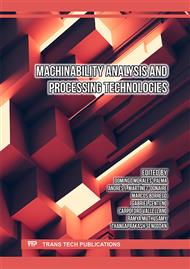[1]
A. Poudel, M.S. Yasin, J. Ye, J. Liu, A. Vinel, S. Shao, et al, Feature-based volumetric defect classification in metal additive manufacturing, Nat. Commun. 13 (2022) 6369.
DOI: 10.1038/s41467-022-34122-x
Google Scholar
[2]
R. Jiménez-Pacheco, S. Ontiveros, J.A. Yagüe-Fabra, F. Zanini F, S. Carmignato, J.A. Albajez, Assessment of Gradient-Based Algorithm for Surface Determination in Multi-Material Gap Measurements by X ray Computed Tomography, Materials 13 (2020) 5650.
DOI: 10.3390/ma13245650
Google Scholar
[3]
H. Villarraga-Gómez, E.L. Herazo, S.T. Smith, X-ray computed tomography: from medical imaging to dimensional metrology, Precis. Eng. 60 (2019) 544-569.
DOI: 10.1016/j.precisioneng.2021.03.007
Google Scholar
[4]
H. Villarraga-Gómez, J.D. Thousand, S.T. Smith, Empirical approaches to uncertainty analysis of x-ray computed tomography measurements: a review with examples, Precis. Eng. 60 (2020) 249-268.
DOI: 10.1016/j.precisioneng.2020.03.004
Google Scholar
[5]
A. Thompson, I. Maskery, R.K. Leach, X-ray computed tomography for additive manufacturing: a review, Meas. Sci. Technol. 27 (2016) 072001.
DOI: 10.1088/0957-0233/27/7/072001
Google Scholar
[6]
B. Blakey-Milner, P. Gradl, G. Snedden, M. Brooks, J. Pitot, E. Lopez, et al, Metal additive manufacturing in aerospace: A review, Mater. Des. 209 (2021) 110008.
DOI: 10.1016/j.matdes.2021.110008
Google Scholar
[7]
F.H. Kim, A.L. Pintar, S.P. Moylan, E.J. Garboczi, The influence of X-Ray computed tomography acquisition parameters on image quality and probability of detection of additive manufacturing defects, J. Manuf. Sci. Eng. 141 (2019) 111002.
DOI: 10.1115/1.4044515
Google Scholar
[8]
J. Lambert, A.R. Chambers, I. Sinclair, S.M. Spearing, 3D damage characterisation and the role of voids in the fatigue of wind turbine blade materials, Compos. Sci. Tech. 72 (2012) 337-343.
DOI: 10.1016/j.compscitech.2011.11.023
Google Scholar
[9]
I. Holgado, J. Iglesias, N. Ortega, S. Plaza, A. Pascual, CT image quality influence on different material Edge Response Functions for accurate metrological applications, IOP Conf. Ser. Mater. Sci. Eng. 1193 (2021) 012064.
DOI: 10.1088/1757-899x/1193/1/012064
Google Scholar
[10]
P. Hermanek, S. Carmignato, Porosity measurements by X-ray computed tomography: Accuracy evaluation using a calibrated object, Precis. Eng. 49 (2017) 377-387.
DOI: 10.1016/j.precisioneng.2017.03.007
Google Scholar
[11]
A.F. Obaton, C.G. Klingaa, C. Rivet, K. Mohaghegh, S. Baier, J.L. Andreasen, et al, Reference standards for XCT measurements of additively manufactured parts, 10th Conf. Ind. Comput. Tomogr. (2020) 1-10.
DOI: 10.58286/25111
Google Scholar
[12]
J. Lesseur, B. Tranchand, T. Mancier, A. Montauzier, C. Larignon, S. Perusin, On the use of X-ray microtomography to control artificial defect geometries produced by metal additive manufacturing, Nondestruct. Test. Eval. 37 (2022) 611-630.
DOI: 10.1080/10589759.2022.2085701
Google Scholar
[13]
A. Jansson, A.R. Zekavat, L. Pejryd, Measurement of internal features in additive manufactured components by the use of computed tomography, Dig. Ind. Rad. Com. Tomogr. (2015)
Google Scholar
[14]
M. Kritikos, M. Kusá, M. Kusý, Evaluation of Aluminium Alloy (AlSi9Cu3 (Fe)) Porosity by Destructive and Non-destructive Method (Computed Tomography), Digit. Prod. Syst. Sel. Pap. ISPR2021 (2022) 181-191.
DOI: 10.1007/978-3-030-90421-0_15
Google Scholar



